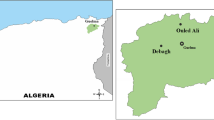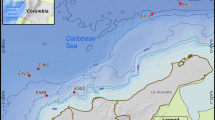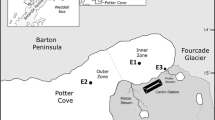Abstract
At the desert oasis of Cuatro Ciénegas in Coahuila, México, more than 300 oligotrophic pools can be found and a large number of endemic species of plants and animals. The most divergent taxa of diatoms, snail and fishes are located in the Churince hydrological system, where we analyzed the local diversification of cultivable Firmicutes and Actinobacteria. The Churince hydrological system is surrounded by gypsum dunes and has a strong gradient for salinity, temperature, pH and dissolved oxygen. In August 2003, surface water samples were taken in 10 sites along the Churince system together with the respective environmental measurements. 417 thermo-resistant bacteria were isolated and DNA was extracted to obtain their BOX-PCR fingerprints, revealing 55 different patterns. In order to identify similarities and differences in the diversity of the various sampling sites, an Ordination Analysis was applied using Principal Component Analysis. This analysis showed that conductivity is the environmental factor that explains the distribution of most of the microbial diversity. Phylogenetic reconstruction from their 16S rRNA sequences was performed for a sample of 150 isolates. Only 17 sequences had a 100% match in the Gene Bank (NCBI), representing 10 well known cosmopolitan taxa. The rest of the sequences cluster in 22 clades for Firmicutes and another 22 clades for Actinobacteria, supporting the idea of high diversity and differentiation for this site.





Similar content being viewed by others
References
Alcaraz LD, Olmedo G, Bonilla G, Cerritos R, Hernández G, Cruz A, Ramírez E, Putonti C, Jiménez B, Martinez E, López V, Arvizu JL, Ayala F, Razo F, Caballero J, Siefert J, Eguiarte L, Vielle J-P, Martinez O, Souza V, Herrera-Estrella A, Herrera-Estrella L (2008) The genome of Bacillus coahuilensis reveals adaptations essential for survival in the relic of an ancient marine environment. Proc Natl Acad Sci USA 105:5803–5808
Alcaraz LD, Moreno-Hagelsieb G, Souza V, Herrera-Estrella L, Olmedo G (2010) Understanding the evolutionary relationships and major traits of Bacillus through comparative genomics. BMC Genomics. http://www.biomedcentral.com/1471-2164/11/332
Badino G, Bernabei T, De Vivo A, Giulivo I, Savino G (2004) Under the desert: the mysterious waters of Cuatro Ciénegas, 1st edn. Italy Associazione geografica La Venta, Treviso
Balkwill DL, Fredrickson JK, Thomas JM (1989) Vertical and horizontal variations in the physiological diversity of the aerobic chemoheterotrophic bacterial microflora in deep southeast coastal plain subsurface sediment. Appl Environ Microbiol 55:1058–1065
Benlloch S, López-López A, Casamayor E, Øvreås LO, Goddard V, Daae Frida L, Smerdon G, Massana R, Joint I, Thingstad F, Pedrós-Alió C, Rodríguez-Valera F (2002) Prokaryotic genetic diversity throughout the salinity gradient of a coastal solar saltern. Environ Microbiol 4:349–360
Carson EW, Dowling TE (2006) Influence of hydrogeographic history and hybridization on the distribution of genetic variation in the pupfishes Cyprinodon atrorum and C. Mol Ecol 15:667–679
Casamayor E, Calderon-Paz J, Pedrós Alió C (2004) 5S rRNA fingerprints of marine bacteria, halophilic archaea and natural prokariotic assemblages along a salinity gradient. FEMS Microbiol Ecol 34:113–119
Cerritos R (2008) Análisis de concepto biológico, ecológico, cohesivo y filogenético de especie en bacterias halófilas del valle de Cuatro Ciénegas, Coahuila. PhD Thesis, Instituto de Ecología UNAM, México
Cerritos R, Vinuesa P, Eguiarte L, Herrera-Estrella L, Alcaraz-Peraza L, Arvizu-Gómez J, Olmedo G, Ramirez E, Siefert J, Souza V (2008) Bacillus coahuilensis sp. nov. a new moderately halophilic species from pond in the Cuatro Ciénegas Valley in Coahuila, México. Int J Syst Evol Microbiol 58:919–923
Chaturvedi P, Shivaji S (2006) Exiguobacterium indicum sp. nov., a psychrophilic bacterium from the Hamta glacier of the Himalayan mountain ranges of India. Int J Syst Evol Microbiol 56(Pt 12):2765–2770
Cohan F (2003) What are bacterial species? Annu Rev Microbiol 56:457–458
Crump BC, Hopkinson C, Sogin M, Hobbie JE (2004) Microbial biogeography along an estuarine salinity gradient: combined influences of bacterial growth and residence time. Appl Environ Microbiol 70:1494–1505
Winsborough BM, Theriot E, Czarnecki, DB (2008) Diatoms on a continental “island”: Lazarus species, marine disjuncts and other endemic diatoms of the Cuatro Ciénegas basin, Coahuila, México. University of Texas, 257 pp
Dean-Ross D, Mills AL (1989) Bacterial community structure and function along a heavy metal gradient. Appl Environ Microbiol 55:2002–2009
Demergasso L, Casamayor E, Chong G, Galleguillos P, Escudero L, Pedrós-Alió C (2004) Distribution of prokaryotic genetic diversity in athalassohaline lakes of the Atacama desert Northern Chile. FEMS Microbiol Ecol 48:57–69
Desnues C, Rodriguez-Brito B, Rayhawk S, Kelley S, Tran T, Haynes M, Liu H, Burlan M, Wegley L, Chau B, Ruan Y, Hall D, Angly FE, Edwards RA, Li L, Thurber RV, Reid RP, Siefert J, Souza V, Valentine DL, Swan BK, Breitbart M, Rohwer F (2008) Biodiversity and biogeography of phages in modern stromatolites and thrombolites. Nature 452:340–343
Earl AM, Losick R, Kolter R (2007) Bacillus subtilis genome diversity. J Bacteriol 189:1163–1170
Elser JJ, Schambel JH, Kyle M, Watts J, Carson EW, Dowling TE, Tang C, Roopnarine PD (2005) Response of grazing snails to phosphorus enrichment of modern stromatolitic microbial communities. Freshw Biol 50:1808–1825
Escalante AE, Eguiarte LE, Espinosa-Asuar L, Forney LJ, Noguez AM, Souza V (2008) Diversity of aquatic prokaryotic communities in the Cuatro Ciénegas basin. FEMS Microbiol Ecol 65:50–60
Escalante E, Caballero-Mellado J, Martinez-Aguilar L, Rodriguez-Verdugo A, Gonzalez-Gonzalez A, Toribio-Jimenez J, Souza V (2009) Pseudomonas cuatrociénegasensis sp. nov., isolated from an evaporating lagoon in the Cuatro Ciénegas valley in Coahuila, México. Int J Syst Evol Microbiol 59:1416–1420
Hall TA (1999) BioEdit: a user-friendly biological sequence alignment editor and analysis program for Windows 95/98/NT. Nucleic Acids Symp Ser 41:95–98
Hubert C, Loy A, Nickel M, Arnosti C, Baranyi C, Bruchert V, Ferdelman T, Finster K, Mønsted Christensen F, Rezende JR, Vandieken V, Jørgensen BB (2009) Into the cold arctic seabed a constant flux of diverse thermophilic bacteria. Science 325:1541
Huelsenbeck JP, Ronquist FR (2001) MrBayes: Bayesian inference of phylogenetic trees. Bioinformatics 17:754–755
Istock CA, Duncan KE, Ferguson N, Zhou X (1992) Sexuality in a natural population of bacteria—Bacillus subtilis challenges the clonal paradigm. Mol Ecol 1:95–103
Jiang S, Sun W, Chen M, Dai S, Zhang L, Liu Y, Lee KJ, Li X (2007) Diversity of culturable actinobacteria isolated from marine sponge Haliclona sp. Antonie van Leeuwenhoek 92:405–416
Johannesson HK, Cortés A, Kilroy KC (2004) Reconnaissance isotopic and hydrochemical study of Cuatro Ciénegas groundwater, Coahuila, México. South Am Earth Sci 17:171–180
Johnson SG (2005) Age, phylogeography and population structure of the microendemic banded spring snail, Mexipyrgus churinceanus. Mol Ecol 14:2299–2311
Kaartokallio H, Laamanen M, Sivonen K (2005) Responses of Baltic sea ice and open-water natural bacterial communities to salinity change. Appl Environ Microbiol 71:4364–4371
Laamenem MJ, Forsström L, Sivonen K (2002) Diversyty of Aphanizomenom flos-aquae (Cyanobacterium) populations along a Baltic sea salinity gradient. Appl Environ Microbiol 68:5296–5303
Lane DJ (1991) 16S/23S rRNA sequencing. Nucleic acid techniques. In: Strackebrant E, Goodfellow M (eds) Bacterial systematics. Wiley, New York, NY, pp 115–175
Larget B, Simon DL (1999) Markov chain Monte Carlo algorithms for the Bayesian analysis of phylogenetic trees. Mol Biol Evol 16:750–759
Ludwig JA, Reynolds JF (1998) Principal component analysis. In: Ludwig JA, Reynolds JF (eds) Statitistical ecology. A primer on methods, computing. Wiley, New York, NY, pp 223–241
Maron PA, Lejon DPH, Carvalho E, Bizet K, Lemanceau P, Ranjard L, Mougel C (2005) Assessing genetic structure and diversity of airborne bacterial communities by DNA fingerprinting and 16S rDNA clone library. Atmos Environ 39:3687–3695
Meyer ER (1973) Late-quaternary paleoecology of the Cuatro Ciénegas basin, Coahuila, México. Ecology 54:982–995
Minckley TA, Jackson ST (2008) Ecological stability in a changing world? Reassessment of the paleoenvironmental history of Cuatro Ciénegas, México. J Biogeogr 35:188–190
Minkley WL (1984) Cuatro Ciénegas fishes: research review of a local test of diversity vesus habitat size. Arizona-Nevada Acad Sci 19:13–21
Porwal S, Cheema LS, Kalia VC (2009) Phylogeny in aid of the present and novel microbial lineages: diversity in Bacillus. PLoS ONE 4(2):4438
Rademaker JL, de Brujin FJ (1998) Characterization and classification of microbes by rep-PCR genomic fingerprinting and computer assisted pattern analysis. In: Akkermans ADL, van Elsas JE, de Brujin FJ (eds) Molecular ecology manual. Kluwer Academic Publishers, Dordrecht, pp 157–159
Rees HC, Grant WD, Jones BE, Heaphy S (2004) Diversity of Kenyan soda lake alkaliphiles assessed by molecular methods. Extremophiles 8:63–71
Roebler M, Müller V (1998) Quantitative and physiological analyses of chloride dependence of growth of Halobacillus halophilus. Appl Environ Microbiol 64:3813–3817
Rohlf JF (1998) NTSYS-pc numerical taxonomy and multivariate analysis system (2.02c). Exeter Publishing, USA
Sacchi CT, Whitney AM, Mayer LW, Morey R, Steigerwalt A, Boras A, Weyant RS, Popovic T (2002) Sequencing of 16S rRNA gene: a rapid tool for identification of Bacillus anthracis. Emerg Infect Dis 8:1117–1123
SAS (2005) Institute. Cary, NC, USA
Souza V, Espinoza-Asuar L, Escalante AE, Eguiarte LE, Farmer J, Forney L, Lloret L, Rodríguez-Martinez JM, Soberon J, Dirzo R, Elser JJ (2006) An endangered oasis of aquatic microbial diversity in the Chihuahuan desert. Proc Nat Acad Sci USA 17:6565–6570
Souza V, Eguiarte LE, Siefert J, Elser JJ (2008) Microbial endemism: does phosphorous limitations enhance speciation? Nat Rev Microbiol 6:559–564
Spring S, Ludwig W, Marquez MC, Ventosa A, Schleifer KH (1996) Halobacillus gen. nov. with descriptions of Halobacillus litoralis sp. nov. and Halobacillus trueperi sp. nov., and transfer of Sporosarcina halophila to Halobacillus halophilus comb. nov. Int J Syst Bacteriol 46:492–496. doi:10.1099/00207713-46-2-492
Stackebrandt E, Goebel BM (1994) Taxonomic note: a place for DNA–DNA reassociation and 16S rRNA sequence analysis in the present species definition in bacteriology. Int J Syst Bacteriol 44:846–849
Stackebrandt E, Frederiksen W, Garrity JM, Grimont PAD, Kampfer P, Maiden CJM, Nesme X, Rosello-Mora R, Swings J et al (2002) Report of the ad hoc committee for the re-evaluation of the species definition in bacteriology. Int J Syst Evol Microbiol 52:1043–1047
Staley JT, Gosink JJ (1999) Poles apart: biodiversity and biogeography of sea ice bacteria. Annu Rev Microbiol 53:189–215
Szynkiewicza A, Ryan C, Ewing C, Craig H, Moorea MG, Bustose D, Pratta LM (2009) Origin of terrestrial gypsum dunes—implications for Martian gypsum-rich dunes of Olympia Undae. Geomorphology 121:69–83
Taylor DW (1966) A remarkable snail fauna from Coahuila, México. Veliger 9:152–228
Thompson JD, Gibson TJ, Plewniak F, Jeanmougin F, Higgins DG (1997) The ClustalX Windows interface: flexible strategies for multiple sequence alignment aided by quality analysis tools. Nucleic Acids Res 24:4876–4882
Tiago I, Chung AN, Verissimo A (2004) Bacterial diversity in a nonsaline alkaline environment heterotrophic aerobic populations. Appl Environ Microbiol 70:7378–7387
Tobler M, Carson EW (2010) Environmental variation, hybridization, and phenotypic diversification in Cuatro Ciénegas pupfhes. J Evol Biol 23:1475–1489
Vinuesa P, Rademaker JL, de Brujin FJ, Werner D (1998) Genotypic characterization of Brayrhizobium strains nodulating endemic woody legumes of the Canary Island by PCR- restriction fragment length polymorphism analysis of genes encoding 16S rRNA (16S rRNA) and 16S–23S rRNA intergenic spacers, repetitive extragenic palindromic PCR genomic fingerprinting and partial 16S rRNA sequencing. Appl Environ Microbiol 64:2096–2104
Yoon JH, Kim IG, Kang KH, Oh TK, Park YH (2003) Bacillus marisflavi sp. nov. and Bacillus aquimaris sp. nov., isolated from sea water of a tidal flat of the Yellow sea in Korea. Int J Sys Evol Microbiol 53:1297–1303
Acknowledgments
This research was supported by an UNAM scholarship to RC, as well as grants from SEMARNAT (0237, 23459) and CONACyT SEP (44673 and 57507) to VS and LE. We thank A Escalante, L Espinosa, R González and A Cruz for their helpful opinions, fieldwork and or laboratory support. Special thanks to A Zavala for statistical support, L Falcon and R Salas for thoughtful comments. JS is supported by NASA’s Exobiology program (US), and MT is supported by the NSF (US). LEE and VS worked in this manuscript while in sabbatical at UCI (US) supported by UC-Mexus and DGAPA–UNAM, respectively.
Author information
Authors and Affiliations
Corresponding author
Rights and permissions
About this article
Cite this article
Cerritos, R., Eguiarte, L.E., Avitia, M. et al. Diversity of culturable thermo-resistant aquatic bacteria along an environmental gradient in Cuatro Ciénegas, Coahuila, México. Antonie van Leeuwenhoek 99, 303–318 (2011). https://doi.org/10.1007/s10482-010-9490-9
Received:
Accepted:
Published:
Issue Date:
DOI: https://doi.org/10.1007/s10482-010-9490-9




